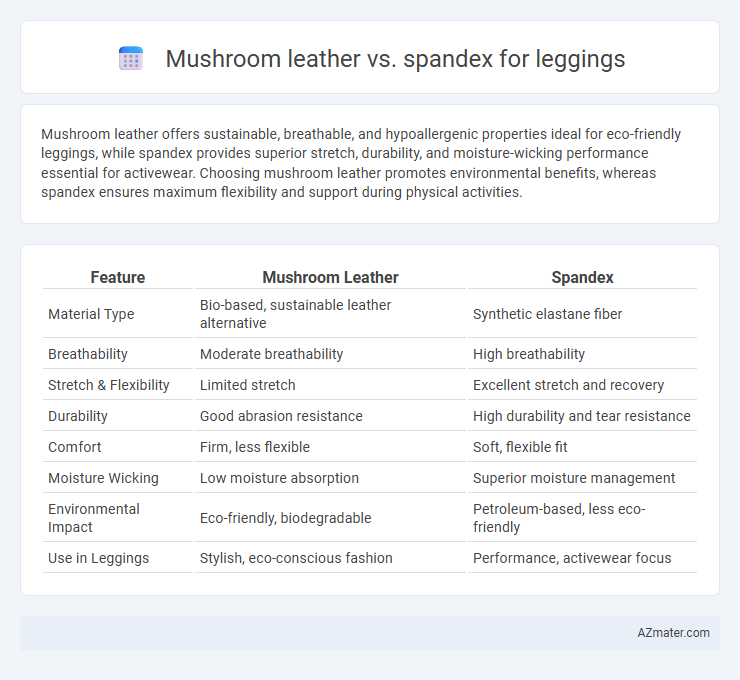Mushroom leather offers sustainable, breathable, and hypoallergenic properties ideal for eco-friendly leggings, while spandex provides superior stretch, durability, and moisture-wicking performance essential for activewear. Choosing mushroom leather promotes environmental benefits, whereas spandex ensures maximum flexibility and support during physical activities.
Table of Comparison
| Feature | Mushroom Leather | Spandex |
|---|---|---|
| Material Type | Bio-based, sustainable leather alternative | Synthetic elastane fiber |
| Breathability | Moderate breathability | High breathability |
| Stretch & Flexibility | Limited stretch | Excellent stretch and recovery |
| Durability | Good abrasion resistance | High durability and tear resistance |
| Comfort | Firm, less flexible | Soft, flexible fit |
| Moisture Wicking | Low moisture absorption | Superior moisture management |
| Environmental Impact | Eco-friendly, biodegradable | Petroleum-based, less eco-friendly |
| Use in Leggings | Stylish, eco-conscious fashion | Performance, activewear focus |
Introduction to Sustainable Legging Materials
Mushroom leather, derived from mycelium, offers a biodegradable and eco-friendly alternative to synthetic fabrics used in leggings, emphasizing renewable resource use and reduced environmental impact. Spandex, a synthetic fiber known for its exceptional elasticity, is widely used for leggings but relies on petrochemicals and has limited biodegradability. Choosing mushroom leather supports sustainability goals by minimizing plastic waste and promoting innovative biomaterials in fashion.
What is Mushroom Leather?
Mushroom leather, also known as mycelium leather, is a sustainable material derived from the root structure of mushrooms, offering an eco-friendly alternative to traditional fabrics. Unlike spandex, which is a synthetic fiber known for its elasticity and stretch in leggings, mushroom leather provides a biodegradable and cruelty-free option that mimics the texture and durability of animal leather. This innovative material combines durability, breathability, and a lower environmental impact, making it a promising choice for sustainable activewear and fashion items.
Understanding Spandex: Composition and Uses
Spandex, also known as elastane or Lycra, is a synthetic fiber made from a long-chain polymer called polyurethane, renowned for its exceptional elasticity and recovery. Commonly used in activewear and leggings, spandex provides superior stretch, flexibility, and shape retention, making it ideal for form-fitting garments requiring high durability and moisture-wicking properties. Unlike mushroom leather, which is biodegradable and eco-friendly, spandex is petroleum-based and less sustainable but offers unmatched performance in stretchy apparel applications.
Production Process: Mushroom Leather vs Spandex
Mushroom leather is produced through a sustainable process involving the cultivation and extraction of mycelium from fungi, which is then treated and dried to create a durable, biodegradable material. In contrast, spandex is synthesized through a chemical process involving the polymerization of polyurethane, relying on fossil fuels and energy-intensive manufacturing methods. Mushroom leather's eco-friendly production reduces environmental impact, while spandex manufacturing involves higher carbon emissions and non-renewable resource consumption.
Eco-Friendly Benefits: Mushroom Leather Advantages
Mushroom leather, derived from sustainable mycelium fungi, offers significant eco-friendly benefits compared to traditional spandex used in leggings. Unlike spandex, which relies on petroleum-based synthetic fibers, mushroom leather is biodegradable and produced through low-impact processes that reduce water and chemical usage. This renewable material also supports carbon sequestration, making mushroom leather a superior choice for environmentally conscious activewear.
Durability and Performance in Activewear
Mushroom leather in leggings offers superior durability due to its tough, moisture-resistant surface that withstands frequent wear and sweat, making it ideal for intense workouts. Spandex excels in flexibility and stretch, providing excellent range of motion and comfort but may lose shape over time with heavy use. For activewear performance, mushroom leather supports longevity and abrasion resistance, while spandex ensures breathability and a snug fit during dynamic activities.
Comfort and Fit Comparison
Mushroom leather offers exceptional breathability and natural moisture-wicking properties, enhancing comfort during extended wear compared to traditional spandex leggings. Its flexible yet durable texture provides a snug fit that molds to the body without excessive compression, reducing irritation and improving freedom of movement. In contrast, spandex leggings deliver high elasticity and shape retention but may trap heat and cause discomfort over long periods due to less effective ventilation.
Style and Aesthetic Potential
Mushroom leather offers a unique, eco-friendly aesthetic with a matte finish and natural texture that creates a sophisticated, earthy look appealing to sustainable fashion enthusiasts. Spandex provides a sleek, glossy appearance with high elasticity, enhancing body contours for a smooth, sporty, and modern style ideal for activewear. The choice between mushroom leather and spandex leggings depends on whether the wearer prioritizes a natural, avant-garde vibe or a classic, high-performance silhouette.
Price and Market Availability
Mushroom leather leggings generally have a higher price point due to their sustainable and innovative material sourcing, often costing 20-40% more than spandex leggings. Spandex leggings dominate the market with widespread availability and affordability, typically priced between $20 and $50, while mushroom leather leggings remain niche, found mainly in specialty eco-friendly fashion stores. Consumer demand for sustainable fashion is gradually increasing mushroom leather's market presence, but spandex remains the most accessible and economically practical option for mass-market legwear.
Future Trends in Legging Fabric Innovation
Mushroom leather offers a sustainable and biodegradable alternative to synthetic materials like spandex, aligning with the growing demand for eco-friendly activewear fabrics. Innovations in mycelium-based textiles enable leggings that combine durability, breathability, and moisture-wicking properties, which are key features consumers increasingly seek. Future trends indicate a shift toward hybrid fabrics integrating mushroom leather with stretchable fibers to enhance comfort while maintaining environmental responsibility.

Infographic: Mushroom leather vs Spandex for Legging
 azmater.com
azmater.com